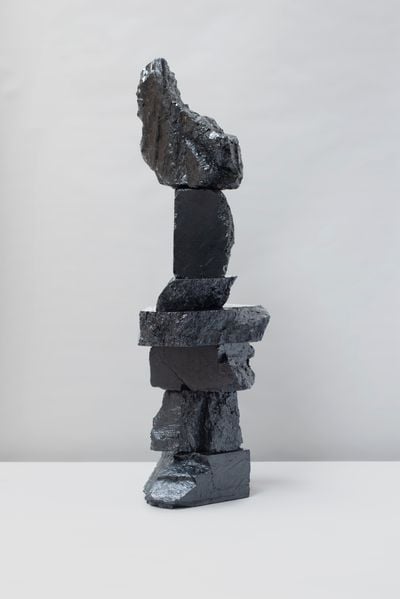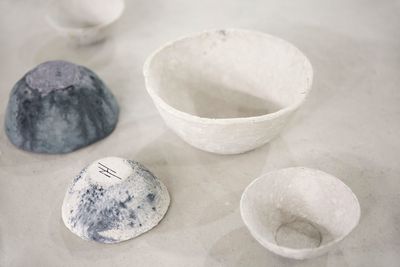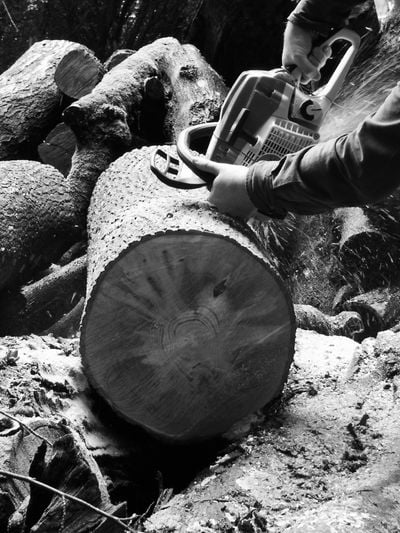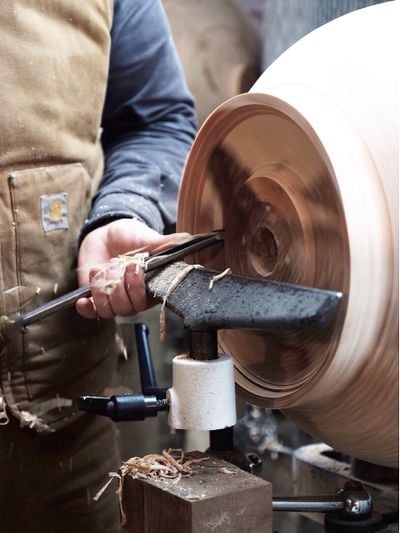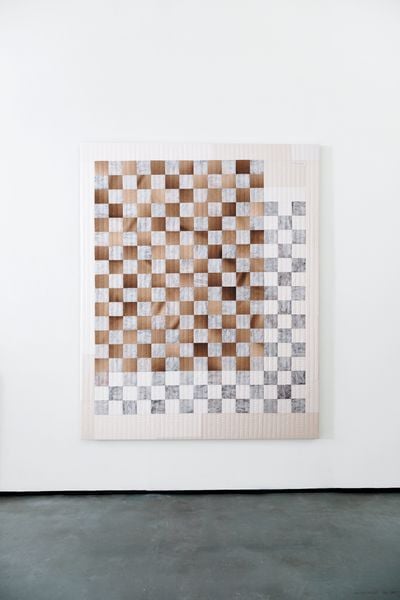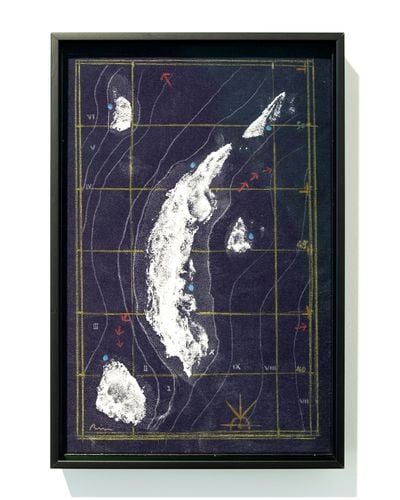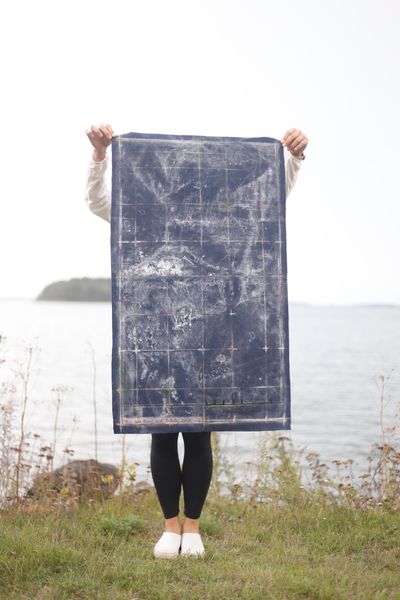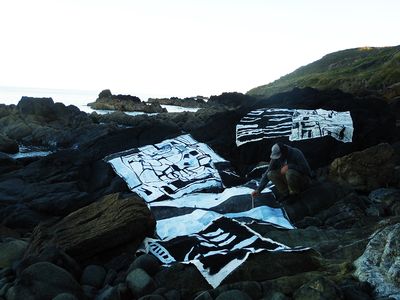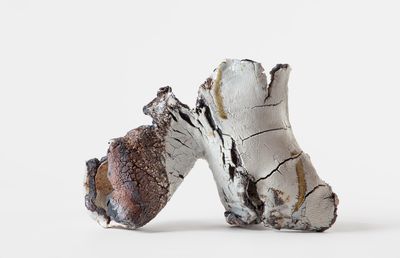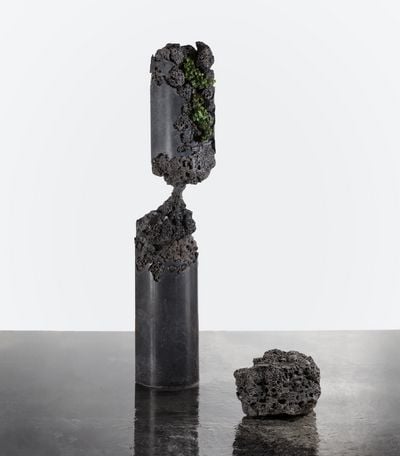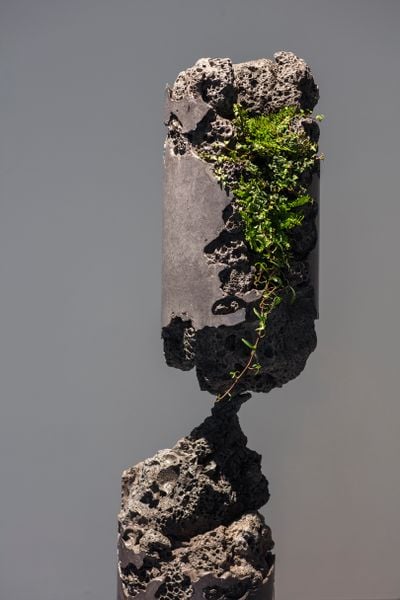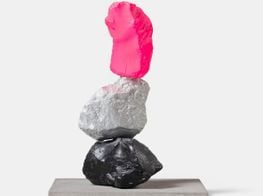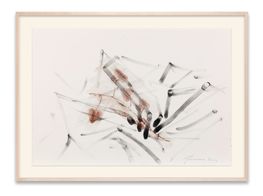From Nature: The Materials Are the Message
In Partnership with Informality
In From Nature, seven contemporary artists use materials as central contributors to how their art finds meaning, and do so with a radical respect for the materials themselves.
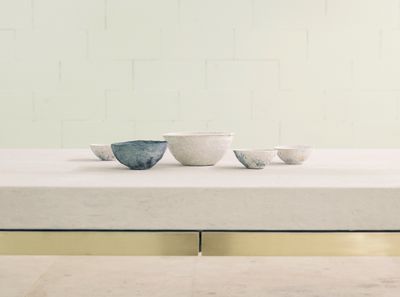
Nienke Hoogvliet, Waterschatten bowls (2020). Used toilet paper, natural glue and Vivianite paint. Courtesy Informality.
Opening at Informality in the British town of Henley-on-Thames on 18 February 2021, works respond to critical shifts in perceptions of the environment since the 1960s and an increasingly evident need to act more responsibly towards nature.
Take Jesper Eriksson, who works with coal, a charged and double-edged material. Eriksson says coal is 'problematic, glorious, scandalous, essential'—'it has sustained communities and enabled technological progress, all the while polluting and harming the health of those who work it'.1 That led him to make the point that 'it is the carbon dioxide released from burning which is at fault, not the material itself. Imagine it was mined as a building material, rather than as an energy source.'2
For building material, read sculptural material. As such, coal is displayed to draw attention to its easily overlooked beauty—its value beyond the problematic history of its destruction for humanity's short-term gain.
Eriksson calls attention to the environmental agenda, effectively memorialising climate change and pointing—through the title of his 'Carbon Offset' series (2020)—to the potentially flawed logic of 'offsetting' carbon emissions by making payments.
Eriksson's stacks, incidentally, resemble the tradition of cairns, but the form also has a recent art usage in Ugo Rondinone's 'Mountain' series of hyper-coloured Day-Glo-painted rocks, which flaunt the artist's intervention, where Eriksson keeps his input in the background.
Nienke Hoogvliet and her studio generate value from the least likely materials: seaweed (woven), algae (turned into yarn), and, in From Nature, used toilet paper and sewage wastewater.
The Waterschatten range of furniture and homeware is made from reclaimed and recycled toilet paper: some 180,000 tonnes is flushed down Dutch toilets each year,3 likely equating to over 600,000 tonnes in the U.K. A recent Dutch innovation uses fine sieves to collect the paper as a cellulose—saving trees through the recycling achieved.4
Hoogvliet's Kaumera Kimono (2018), also on view in this exhibition, looks at the environmental issues caused by the textile industry, including the scale of production (80 billion garments sold per year) and the pollution of water a result of textile dyeing processes.
The artists in the exhibition channel the aesthetic and conceptual richness that comes with an engagement with nature's materials and processes...
What's needed, Hoogvliet makes apparent, is a more balanced valuation of clothes, taking account of sustainability as well as prices and trends. Her recycling of materials to design ends succeeds in both calling attention to environmental issues, and taking direct action to improve matters. The choice of garment—a kimono—is a statement against 'fast fashion', as kimonos are traditionally passed on for generations.
In their explorations of new languages of craft, Forest & Found (Max Bainbridge and Abigail Booth in collaboration) use traditional techniques to create art from found and reclaimed material. They work independently to produce joint installations linked by the exploration of identity and place through expanded material histories and handwork.
Bainbridge's titles emphasise the story of his materials: the Land Jars (2020) are made from storm-felled sections of ash trees, a defining part of the British landscape, albeit one threatened by dieback. Bainbridge turns and hollows out these sections—one burnished, one burnt—through the end grain of the wood to mirror the central trunk of the tree, so that the width of each jar is indicative of the diameter of the tree from which it was carved.
Bainbridge's elegant manoeuvre might be related to Giuseppe Penone's well-known series (from 1969 onwards) in which he scrapes away the wood from a felled tree to reveal its internal structure of narrow core and developing branches, uncovering the process of growth.
Bainbridge conjures a similar sense of connection to the origin of the tree, a discovery within the wood of the essence of its being.
Abigail Booth's works also generate power through their materials. The cloth she uses for In Dreams (Dormir) (2020), for example, is a mixture of cottons, some of them 'burnt' by baking in a domestic oven. The chequered pattern enables Booth to contrast the 'raw' and 'cooked' sections—to borrow Lévi-Strauss's distinction, with its relevant evocation of the analysis of myth.
The pigment painted onto the cloth is made from wood-fired cow bones ground and mixed with linseed and beeswax. Booth emphasises that the bones—a discarded by-product of the cattle industry—are not just the last tangible presence of the animal itself. The bones are also no different from, and therefore evocative of, human bones.
Her title, though, comes not from the material but from its associations: suggesting that we are looking at a quilt, under which we sleep and dream.
British-Taiwanese artist Rain Wu's series of fictional maps call attention to the subjectivity of cartography, which inevitably encodes the ideological views of its makers—historically, an agenda of domination.
Wu cites Jean Baudrillard's concept of 'hyperreality'—that representations can take over from reality—as pointing to 'how representations (maps) and their original objects (place) have a mutual influence on one another', adding that 'there is more imagination than there are facts on a map'.5
Wu's maps are fugitive in nature. Those in the series, 'The Sea Rises and Totally Still' (2019–2020), first shown outdoors on an archipelago in Finland in 2019, are drawn on stretches of blue fabric with seawater and chalk, so that their markings fade away on exposure to the atmosphere.
Wu foregrounds a disappearance that reminds us not only of our mortal temporality, but also of our composition: not only is 60 percent of the human body water, but 0.4 percent of its weight is sodium chloride at a concentration pretty well equivalent to that in seawater. Such a mapping amounts to the opposite of domination—an act of reconciliation with nature by drawing directly from it and allowing the artwork to dissolve back into the landscape.
Peter Matthews works literally with the sea: he paints at the edge of the world's oceans with the materials he can carry on his back, his canvas often doubling up as sunscreen, roof, or hammock, even drawing underwater so that, as he puts it, 'the sea is depicting the sea itself'.6
From Nature is a warning, perhaps, to avert the endgame.
All manner of coastal materials may find their way into his paintings as he records what he experiences in a stream-of-consciousness manner. In the case of Emerge (2020), sand, stones, a grass reed, flower petals, and a cuttlefish bone from the Atlantic coast of Cornwall contribute to a restrained palette that enables small pools of sea-suggestive blue to gleam from a composition that can be read as both a radical mapping and a riff on the modernist grid.
Shown alongside Matthews' paintings is a film showing their making; just as Harriet Hellman also films herself at the coast of Devon. Here, she records her process of working with clay in a performative interaction with the landscape, which she describes as an attempt 'to capture place, space and time and the energy of the moment' so that 'the physicality of the coastline embeds itself in the clay, layering a new narrative' that is 'both immediate and meditative'.7
Sometimes Hellman leaves her work on site, returning some days later to see what has changed, regarding the transformation as a 'gift from the sea.'8 Hellman's ceramics point to a concern for ecological fragility, which she finds powerfully present and concerning in coastal erosion and rising sea levels.
The final fired form of Hellman's ceramic sculptures evokes geological formations with a notable sense of flow, as if the deep history of the land feeds directly into the work it inspires while reminding us that the formation of the coastal landscape is rooted in the erosive action of waves.
Hellman's titles, such as Anthropocene Wave or Tipping Point (both 2020), tend to reference deep time as well as the current acceleration of its processes: a connection to Australian artist Jamie North's sculpture Forward Projection (2019). The top of a time-weathered column, seemingly eroded so that its central body has thinned to a fine point, projects forward in a paradoxical manner: what could the column have originally looked like?
The shifted column refers to a tipping point or the crossing of an ecological threshold resulting in a new systemic direction. Its title suggests that we are looking at a forecast of what is to come: archetypal industrial materials—concrete, blast furnace slag, steel—play host in their distressed state to ferns and ivy.
Todd McMillan points out that, though we think of columns as support structures, North's column 'appears defeated, created to be always and already broken. Yet, in its decrepitude, it retains its function of support . . . That which appears in the process of decay has provided a home for native species to thrive.'9 The world, it seems, will survive the passing phase of humanity and absorb its history into a new order.
With that scenario seeming all too probable, From Nature is a warning, perhaps, to avert the endgame. The artists in the exhibition channel the aesthetic and conceptual richness that comes with an engagement with nature's materials and processes, reminding us why—instinctive self-interest aside—humanity is worth preserving.—[O]
This text has been edited in partnership with Informality. The original text can be viewed here.
1 Jesper Eriksson, 'Coal: Post-Fuel', artist's website, https://jesper-eriksson.com/publication
2 Ibid.
3 Nienke Hoogvliet, Waterschatten, Studio Nienke Hoogvliet website, https://www.nienkehoogvliet.nl/portfolio/waterschatten/
4 Ibid.
5 Rachel Morón, 'Rain Wu: To Appear and Disappear with Lightness', TLmagazine, 17 March 2020, https://tlmagazine.com/rain-wu-to-appear-and-disappear-with-lightness/
6 Peter Matthews BBC radio interview with Ben Jackson, Peter Matthews website, http://petermatthews.org/about
7 Harriet Hellman, 'About', artist's website, https://www.harriethellman.co.uk/about/
8 Ibid.
9 Todd McMillan, essay for Jamie North: Inflection (11–17 November 2019), Informality, https://www.informality.co/wp-content/uploads/2020/03/JamieNorth_essay_inflection_2019.pdf




